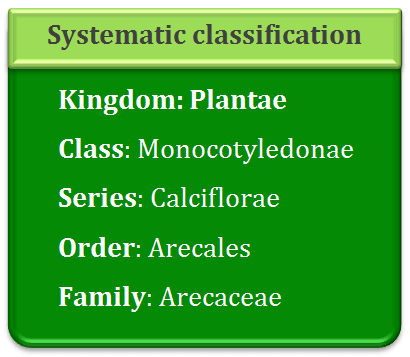
General Information
Common name: Palm family or Palmae
Number of genera: This family includes 217 genera and 2,500 species
Propagation type: Most palms are propagated from seeds. Palms that show root primordia along their stems can be layered to reduce the stem length and those with multiple trunks can be propagated by separating suckers.
Distribution: Generally distributed in tropical and sub-tropical parts of the world. Some palm species are also found in warm temperate regions.
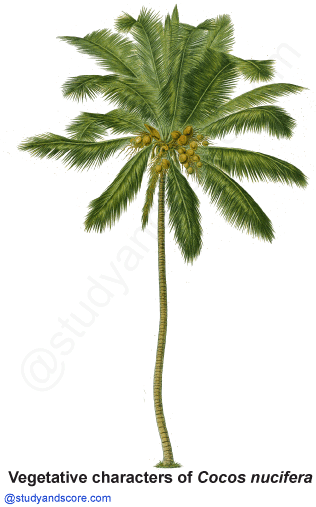
Vegetative characters
Habitat: They are mostly mesophytes and some xerophytes are also found in this family.
Habit: These plants are generally woody shrubs or trees or sometimes vines (Calamus) with usually unbranched, slender to stout stem to over 30 meters tall. Leaves often form a terminal cluster on the tall stem.
Root system: Fibrous and adventitious root are seen in this family which arise from the base of the stem. Some species also have prop roots (Iriartea)
Stem: Stem is variable in different forms such as very short with leaves appearing to arise from ground, thin and slender with long internodes and tall, stout, pillar-like covered by persistent leaf-bases and terminal cluster of leaves. Stems are rarely branched.
Leaf: Leaves are palmate (fan palms) or pinnate (feather palms) and rarely simple. Leaves are usually large with petiole base sheathing the stem. Leaf is usually terminal cluster. Petiole is large and venation is parallel type.
Floral characters
Inflorescence: Inflorescence is usually large, much branched, paniculate or spadix. The inflorescence often reaches up to 1 meter and is covered by boat shaped woody bracts. The inflorescence is interfoliar (arising among the levaes) or intrafoliar (arising below the leaves). Usually these plants are monoecious or dioecious.
Flower: Flowers are ebracteate, sessile, actinomorphic usually unisexual and monoecious but sometimes even dioecious. They are rarely bisexual, trimerous, cyclic (usually), or partially acyclic, hypogynous. The male flowers are usually smaller than the female flowers.
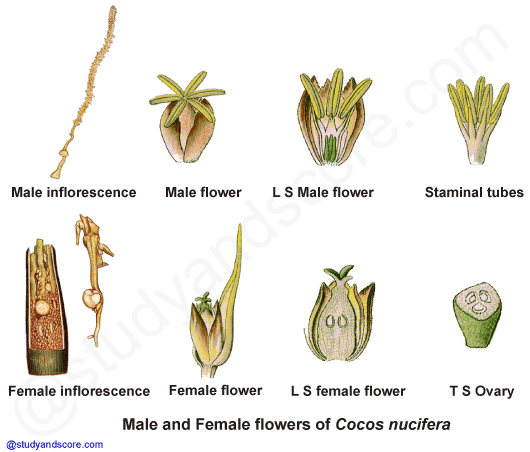
Perianth: Perianth is 6 in number free or united in 2 whorls of 3 each. They are usually tough, leathery and usually persistent. In the bud condition, they are imbricate, valvate and twisted. The tepals of the outer whorl are smaller than that of the inner whorl. Tepals are free or joined. They are sepaloid/petaloid or both sepaloid and petaloid
Androecium: Androecial members free of the perianth, or adnate to the perianth. Total 6 stamens are arranged in 2 whorls of 3 each. Androecium consists exclusively of fertile stamens, or may also include staminodes. Anthers dehisce via vertical slits. They may be basifixed or dorsifixed.
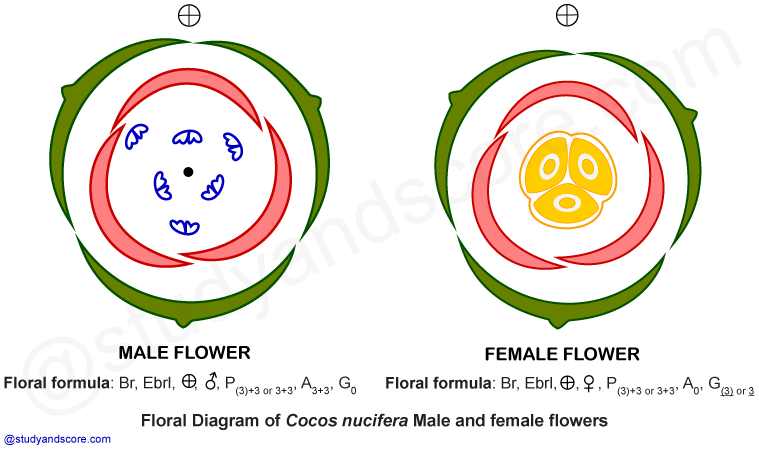
Pistillodes and staminodes: A pistillode is usually present in the centre of each male flower. Staminodes may or may not be present in the female flowers.
Gynoecium: The gynoecium is present only in pistillate or bisexual flowers. Ovary is tricarpellary, unilocular, apocarpous or syncarpous or carpels are completely or partially free. The ovary is unilocular, apocarpous or syncarpous. The ovary may or may not have style. Stigma is dry-type. Single ovule per locule is place on sub-apical or basal placentation..
Pollination: Pollination is usually anemophilous and the flowers are protandrous. Some palms are insect pollinated. The seeds are dispersed to a long distanced by water or animals.
Fruit: Fruit is a berry with fleshy or non-fleshy exocarp or a drupe with fibrous epicarp. Fruit is always single seeded with small embryo and abundant endosperm.
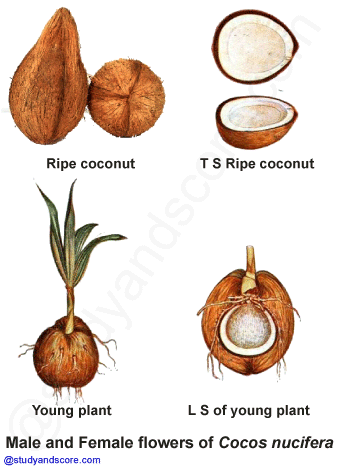
Seed: Seeds endospermic. Endosperm ruminate, or not ruminate; oily (usually), or not oily. Seeds are usually without starch
Important plants of Arecaceae
Family Arecaceae is also called as the palm family. The alternative name of this family is Palmae. This family consists of palm plants. This family has more than 217 genera and around 2,500 species. The members of this family are distributed throughout the world. Its members are characterized by strong trunks and toddy yielding inflorescences.
The following is a list of some important members of family Arecaceae, arranged alphabetically.
- Adonidia merilla (Manila palm),
- Areca catechu (Betel nut palm)
- Arenga pinnata (Wurmb)
- Arenga saccharifolia (Gomuti palm),
- Borassus flabellifer (Palmyra palm)
- Calamus latifolius
- Calamus ovatus
- Calamus rotundatus
- Ceroxylon andicola
- Chamaerops humilis (European fan palm),
- Cocuc nucifera (Coconut palm)
- Copernicia ceribera
- Corypha umbraculifera (Malabar palm)
- Daemonorops ruber (Dragon’s blood)
- Elaeis guineensis (Oil palm)
- Hyphaene thebaica (Egyptian doum palm)
- Heterospathe elata
- Metroxylon rumphii (Sago palm)
- Nympha fruticans (nipa palm)
- Phoenix dactylifera (date palm)
- Phytelephus macrocarpai (Vegetable ivory)
- Sabal minor (bush palm),
- Sabal palmetto (Cabbage palm)
- Caryota urens (Fish-tail palm)
- Chamaerops humilis (European fan-palm)
- Phoenix rupicola
Economic Importance of Arecaceae
Palm family or Arecaceae is the second most important family after family Poaceae. The products from the members of this family are used as food, oil, shelter, decoration, clothing etc.
- Cocos nucifera is a plant from this family which yields wide variety of products. Every part of this plant body is used in some way or the other.
- Root decoction is used as mouthwash and the roasted roots are used as dentifrice.
- Stem is used as fuel and as pillars
- Leaves are used for making mats, fans, baskets and for roof thatching.
- The midrib stalks of the leaves are used for making broom.
- Toddy obtained from the young inflorescence provides an intoxicating alcoholic drink on fermentation.
- Endosperm of the young fruits is edible and their milky fluid is a sweet and refreshing drink
- Vegetable fat obtained from the dried endosperm of matured fruit is used as oil for cooking, making soaps, hair oil, shampoo etc.
- Dried fibrous mesocarp of fruits is used for making brushes, ropes, mats, floor covering
- Woody endocarp of the fruits is used to prepare several decorative articles for interior decoration.
- The large terminal bud is used as vegetable
- Phoenix dactylifera is grown in north-west India. The fruits of this plant have high nutritive value and are edible. These fruits are used in bakery and confectioneries. The stem of this plant is tapped for toddy. The leaves are used for roof thatching.
- Phoenix sylvestris also known as wild date palm is cultivated throughout India. This plant is tapped for its sap which gives an intoxicating alcoholic drink on fermentation. The leaves are used for making fans, mats and roof thatching.
- Borassus flabellifer also known as Palmyra palm is also cultivated throughout India.
- The inflorescence of this plant is tapped to get toddy from which palm sugar and jiggery are made.
- The trunk of this plant is hard, durable and salt resistant. This trunk is used for making crude bridges, sweeps etc. the trunk is also used for making umbrella handles and walking sticks.
- The leaves are used for making fans, baskets and roof thatching. The leaf base fibre is used for making brushes.
- Fruit can be roasted to eat
- The young seedlings are used as vegetable and also flour is made from these seeds.
- Areca catechu, also known as betel nut palm is cultivated in tropical Asia. The seeds of this plant are cut into slices and are chewed along with betel leaves. Fancy beads are also made from these seeds.
- Metroxylon rumphii, Yields sago from the pith of its stem. This sago is used as diet during special convalescence. It is also used in the textile industry for sizing and finishing of cotton yarn.
- Nypa fruticans is a palm found in the brackish waters of Ganges delta.
- The inflorescence of this plant yields sweet sap used for making sugar, jiggery, alcohol and vinegar.
- Tender stem buds are used as vegetable.
- Leaves are used for making mats, baskets and roof thatching. A lotion made from the leaves is use for treatment of ulcers.
- The ash obtained from the burned leaves and roots is used to relieve tooth ache.
- Arenga pinnata is tapped for sap to make palm sugar. The fermented sap is used to produce intoxicating drink. The fruit kernels, tender leaves and sweet stem pith are edible. The fibre obtained from the leaves is used as cordage and for making brushes.
- Copernicia ceribera yields carnauba wax from the leaves which is used in manufacture of candles, boot polishes etc. The fruit of this plant is edible.
- The leaves of Corypha umbraculifera are used as umbrellas. During olden days, the leaves were made as pages of books to write sacred writings.
- The petioles of the plant Sabal palmetto are used for making different types of brushes. The fruits of this plant are edible and the flowers are the source of honey.
- The sweet and fleshy pericarp of Hyphaene thebaica is edible. The trunk provides strong, heavy and compact wood.
- The fleshy mesocarp of Elaeis guineensis is the source of palm oil. This palm oil is edible and also used in the manufacture of soaps, candles and lubricants. It can also be used for internal combustion engines.
- Calamus species are the source of common cane which is used in making of furniture frames, walking sticks and poo sticks. The ropes made from it are very strong and are used for dragging heavy load.
- Daemonorops species yields canes and resinous exudate. This exudate is used for coloring lacquers and varnishes.
- Several palm plant species are used as ornamental plants in gardens for their majestic look and handsome appearance. The following is the list of decorative palms,
- Roystones regia
- Caryota urens
- Livistona chinesis
- Chamaerops humilis
- Arenga saccharifolia
- Phoenix rupicola
- Heterospathe elatas
- Bactris major
- Share with your friends! -




Login to post your comment here...
- or with social Account -